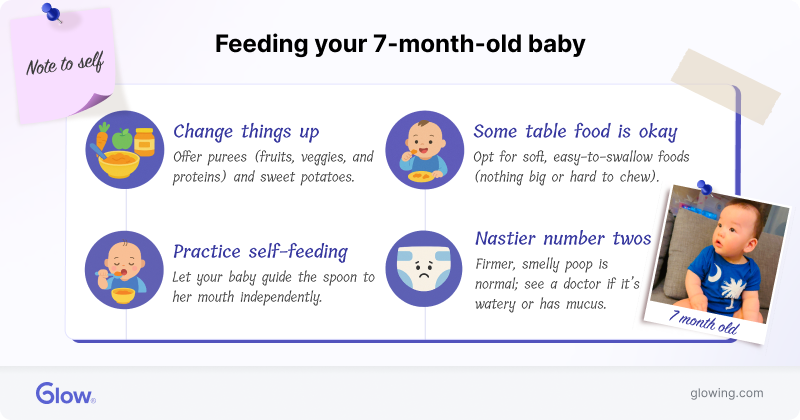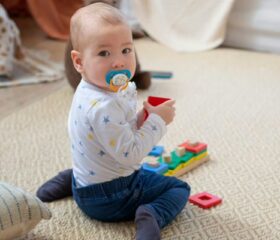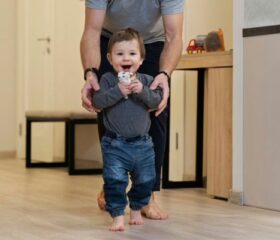Baby Month by Month
7-Month-Old Baby
Your baby can now see in full color.

Your baby is more wide-eyed and curious than she’s ever been, and her physical developments mean she can now reach places she previously couldn’t (and places you’d probably prefer she didn’t!).
Let’s walk through your baby’s developmental milestones this month and prepare you for the challenges that come with them.
Your baby’s development at 7 months old
Expect your baby to become more active and independent in her 7th month. Everything’s new and interesting, so she’ll try to interact with many things.
Your baby’s mobility and vision
You’d better take baby-proofing your house to the next level—your baby’s getting increasingly mobile. Expect some notable changes, including:
- Finding the right moves: Your baby has likely mastered the art of rolling in both directions. She may even use rolling to move around. Expect her to also try different ways to get from Point A to Point B besides this—crawling, creeping, and scooting. She’ll do all of this at her own pace, so don’t worry if she isn’t moving the “right” way.
- Sitting and pulling herself up: Though she’s not quite an expert yet, your baby has likely learned how to sit up by herself. You can help prop her up with pillows or cushions, but never leave her unsupervised.
- Practicing standing: You’ll start to notice your baby trying to hold her weight with her legs when you carry her by her armpits and let her feet touch a stable surface.
- Fine motor skills: Your baby can likely transfer larger things from one hand to another. She’s still getting the hang of grasping smaller objects, often using the pads of her thumb and index finger (the inferior pincer grasp) or her fingers to bring tinier things to her palm (raking grasp). 12
- Better vision: Your baby now sees in full color. She’s also much better at tracking objects and can see things that are farther away. 2
- Cognitive development: Your baby can now find partly hidden things as she starts to explore the world with her hands and mouth. She’ll attempt to grab or reach for objects that she finds interesting. 2
Your baby’s social skills and communication
You’ve got quite the little chatterbox there! Your tyke’s communication skills are getting stronger, and she’s getting more familiar with the people around her.
Baby talk is probably in full swing. You may hear your baby sound out more consonants and respond to speech and other sounds, though she’s not yet at the age when babies start talking for real. She’ll respond to her name and sometimes to “no.”
You’ll also notice that she’s becoming more attuned to your tone of voice and can tell whether you’re happy or sad by how you speak. 3
Getting to know who’s who
You’ll likely see your baby having more fun interacting with family members and people she knows well through games like peek-a-boo or even just by making eye contact. She’ll also start to exhibit signs of separation anxiety since she’s beginning to realize how dependent she is on you for her care. 4
Part of your baby’s emotional and social growth is recognizing when she’s around strangers. She’ll probably be a little uneasy or anxious around unfamiliar people. 5
Your baby’s growth and weight
Your baby is more active now, so her weight and size gain will slow down a bit. On average, by this point:
- Boys weigh around 18 pounds and 5 ounces and measure about 27 1/4 inches long. 6
- Girls tend to weigh around 16 pounds and 12 ounces and measure about 26 1/2 inches long. 7
Remember that these are only averages; there’s a wide range of what is considered “normal.” Multiple factors, like genetics, activity level, and feeding habits all affect your baby’s growth. Talk to your pediatrician if you’re concerned, but as long as they’re satisfied with how she’s progressing, you have nothing to worry about.

Feeding your 7-month-old baby
Because your baby is more active, the kind of food she eats (and likes, too!) will naturally change. Breast milk or formula will still be her primary source of nutrition, but she’ll also be up for exploring her options with solid foods.
Here are some tips for fostering her culinary exploration:
- Change things up: If you haven’t already, continue to introduce a variety of pureed or mashed foods, like fruits (bananas, pears, applesauce), vegetables (carrots, squash, sweet potatoes), and proteins (chicken, beef, tofu, beans). Notably, butternut squash and sweet potatoes are loaded with Vitamin A, which helps her eyesight and boosts her immune system. 8
- Practice self-feeding: Put a little food into your baby’s spoon, but allow her to be the one to put it in her mouth. While she still lacks the coordination for true self-feeding, this is great practice.
- Some table food is okay: If your baby doesn’t like purees, offering her very soft table food is OK, as long as it’s easy to swallow and isn’t a choking hazard.
- Expect nastier number twos: Because your baby is eating more solid food, expect her poop to be firmer and a different color than when she was only drinking milk. They will smell worse, too. All of this is normal, but tell your doctor ASAP if your baby’s stool is very loose, watery, or has blood or mucus. 910
What about breast milk and formula?
As mentioned, breast milk or formula will remain your baby’s main source of nutrition until she’s 12 months old. Most babies consume between 24 to 32 ounces of breast milk or formula daily, spread out over three to five feedings. 11
If you haven’t already, have your baby try using a sippy cup with a small amount of water, milk, or formula. This is so she can start learning how to drink independently.
What about common allergens?
As you continue introducing new foods to your baby, you should also try out foods that are common allergens, such as:
- Eggs
- Tree nuts
- Peanuts
- Wheat
- Soy
- Sesame
- Fish
- Shellfish
Experts agree that feeding your baby these before she turns 1 year old can make her less likely to actually develop allergies to them. 12
How to introduce allergens to your baby safely
Tree nuts and peanuts are choking hazards, so give your baby small amounts of them in the form of smooth nut butters.
Also, remember to follow the 3-day rule—waiting for three days before introducing a new kind of food. This is so your baby’s body has enough time to process the last food and show any effects. 13
Talk to your pediatrician beforehand to get a better idea of your baby’s allergy risk and what you should do in case she has an allergic reaction. This can present as:
- Hives
- Skin rashes
- Facial or oral swelling
- Vomiting within a couple of hours of eating
In case of a severe reaction, like anaphylaxis (trouble breathing), call 911 right away and administer an epinephrine shot if your pediatrician prescribed an auto-injector. (If they didn’t, don’t use one that belongs to someone else in the household—just get emergency medical attention.) 14
Iron is important
Make sure that your baby’s diet includes 10 mg of iron daily. Iron is important for babies as it’s the mineral responsible for carrying oxygen in the blood.
Iron-fortified formula is one way to make sure she’s getting enough. At this stage, you can also give your baby meat, chicken, and eggs, which are all high in iron as well as protein. 15
If your baby has an iron deficiency, she could have a poor appetite, lag behind on developmental milestones, appear pale, or have less energy.
Understanding your little one’s sleep habits
At seven months, your baby’s sleep patterns are likely becoming more predictable. Most babies need roughly 14 hours of sleep daily, including naps. 16 Here are some other things to take note of when it comes to your baby’s sleeping patterns:
- Nighttime sleep: At this age, many babies start sleeping through the night for around 10 hours, but this can vary. 17
- Naps: Your baby is likely taking two naps a day, one in the morning and one in the afternoon.
- Sleep regression: Your baby may experience a temporary sleep regression due to nighttime separation anxiety. Be consistent with your sleep routines, and don’t worry too much; this is usually a phase that will pass.
If you haven’t already, you could consider sleep training your baby. Sleep training aims to teach your baby how to self-soothe (fall asleep independently).
While it’s up to you whether you want to try sleep training, there are a bunch of tried and tested methods. You could opt for a gradual “no tears” method, or the more infamous cry-it-out method (letting your baby cry until she falls asleep).
Establish a consistent bedtime routine
Let your baby know when it’s bedtime. Try a bath, a story, or a song as part of it. Put your baby in her crib when she’s drowsy but still awake to help her learn to fall asleep independently.
How to make sure your baby sleeps safely
Your baby needs a lot of sleep. You need to make sure she sleeps safely as well as soundly.
One thing to be aware of is sudden infant death syndrome (SIDS)—when a baby younger than 1 year old suddenly and inexplicably dies. While it’s still not clear what exactly causes it, most deaths happen during sleep. 18
Many recent mothers are terrified of SIDS—for obvious reasons—but it’s rare, and there are recommendations from the American Academy of Pediatrics (AAP) that will help you prevent it. Here’s how to ensure your baby sleeps safely: 19
- Always put her to sleep on her back in her crib, on a firm mattress.
- Lower the mattress after your baby learns to pull herself up to make sure the crib is safe.
- Don’t use crib bumpers, blankets, pillows, or stuffed animals, as these pose a suffocation risk.
Most experts recommend that your baby sleep in your room (but not on your bed) for at least the first six months, ideally for the first year. The AAP states that sharing a room with your baby reduces the risk of SIDS by 50%.
If you are still using a bassinet, make the transition to a crib as soon as your baby starts pushing herself up on her hands or knees.
Fortunately, you can stop worrying about SIDS altogether after your baby celebrates her first birthday (which, not coincidentally, is also around when babies can sleep with pillows and other soft materials in their cribs).
Playtime and other safety and health considerations
Your baby probably isn’t scheduled for a wellness check-up this month, but there are still several important things you need to be on top of when it comes to her health and safety.
Health checklist
- Vaccines: If your baby is behind on any of her vaccines, schedule a visit to her pediatrician to catch her up. This may include vaccines for Hepatitis B, DTaP, Hib, pneumococcal, polio, rotavirus, as well as her RSV antibody. This is also the time for your baby to get the seasonal flu and COVID-19 vaccines. 20
- Teething: Many babies start teething this month, so your child’s first teeth may be coming through now. If she’s drooling, irritable, has swollen gums, and has changed her sleep or eating patterns, it’s likely because her teeth are starting to come out. Ask your pediatrician about pain relief options. 21
- Coughs: Pay attention to your baby’s coughing. A wet cough with mucus often indicates a cold, while a dry cough can be due to other viruses or irritants. 22
- Dehydration: Make sure your baby doesn’t get dehydrated. Since she’s smaller, she’s more prone to this. 14 Give your baby small sips of water when it’s hot out, and be vigilant about replacing fluids lost to vomiting or diarrhea.
- Skin conditions: Keep an eye out for any change in your baby’s skin, whether it’s the redness of different types of diaper rashes, the stubborn persistence of baby acne, or the startling but harmless scales of cradle cap. Your doctor can guide you on how to treat these conditions, and (if possible) how to prevent them.
- Baby soft spots: Babies are usually born with two soft spots on their head called fontanelles. Your baby’s smaller soft spot (the posterior fontanelle) has probably closed by now, and the larger one (the anterior fontanelle) often closes around this time. If it hasn’t closed yet, be extra careful about avoiding bumps to her head.
When to contact your pediatrician
Most of the health issues that can crop up at this stage are nothing to get worked up about. That said, contact your pediatrician if your baby:
- Seems stiff or floppy
- Doesn’t hold her head up well while sitting
- Seems uninterested in interacting or does not make eye contact
- Isn’t smiling, laughing, or babbling
- Has issues with vision or hearing
- Has poor weight gain
- Misses or hits any other developmental milestones late
These symptoms could indicate she has a neurological or developmental disorder. 23 It’s also possible for them to be caused by less-serious issues that don’t require treatment, but regardless, it’s better to get her checked out.
Keeping things safe for your baby
While your baby’s activity and curiosity are signs she’s developing, she’s now more likely to encounter hazards.
Baby-proof your home by securing cords, covering electrical outlets, and putting gates on all staircases. Place cushioning pads on sharp furniture corners your baby might reach, and always put away small objects she could put in her mouth.
While it can be a challenge to keep the house perfectly clean with your little bulldozer rolling around, make sure the environment she’s in is as tidy as possible.
At 7 months old, your baby should still be in a rear-facing infant car seat. Check the car seat regularly to ensure it’s properly secured and hasn’t been outgrown. Clean the car seat regularly as well.
Tips for learning and playing
There’s more to looking after your baby than just feeding her, putting her to sleep, and cleaning her poop. Playtime is just as important!
- Play social games with your baby, like peek-a-boo or pat-a-cake. Singing songs to her is also a good idea.
- Give your baby toys that encourage movement and exploration, like balls, toys on wheels, and musical toys. You can also have her use toys—always with supervision—that will help her practice standing up or walking.
- Introduce puppets to engage your baby in new stories and games.
- Babies love repetition. Be patient about playing or singing the same song for her, even if you go mildly crazy from it. Repetition helps your baby reinforce the new neural circuits her brain creates when she learns new things. 24
- Your baby will love stretching those little muscles of hers by exploring and moving around on the floor. Better yet, get down with her—she’ll be thrilled when you join in on the fun.
Final thoughts
Welcome to month 7 of your baby’s life! While you may be apprehensive about her burgeoning independence, try to take it easy. As long as you keep an eye on her, she’ll be just fine. So, with a bit more peace of mind, go and have some fun with your little bundle of joy.
Article Sources
- Children’s Hospital of Orange County. "Developmental Milestones: Fine Motor Skills and Visual Motor Skills" Retrieved July 17, 2025.
- American Academy of Pediatrics. "Developmental Milestones: 7 Months" Retrieved July 17, 2025.
- The Health Initiative of the Americas: Berkeley. "Important Milestones By The End Of 7 Months" Retrieved July 17, 2025.
- National Health Service. "Separation anxiety" Retrieved July 17, 2025.
- Kaiser Permanente. "Emotional and Social Development, Ages 1 to 12 Months" Retrieved July 17, 2025.
- U.S. Centers for Disease Control and Prevention. "WHO Growth Chart: Birth to 24 months: Boys: Length-for-Age and Weight-for-Age percentiles" Retrieved July 17, 2025.
- U.S. Centers for Disease Control and Prevention. "WHO Growth Chart: Birth to 24 months: Girls: Length-for-Age and Weight-for-Age percentiles, U.S. Centers for Disease Control and Prevention" Retrieved July 17, 2025.
- WIC South Dakota. "Vitamin A" Retrieved July 17, 2025.
- Children's Hospital Colorado. "Baby Poop Guide" Retrieved July 17, 2025.
- UCSF Benioff Children's Hospitals. "Introducing Your Baby to Solid Foods FAQs" Retrieved July 17, 2025.
- University of Rochester Medical Center. "Feeding Your Baby the First 12 Months" Retrieved July 17, 2025.
- Nutrients. "Early Introduction of Allergenic Foods and the Prevention of Food Allergy" Retrieved July 17, 2025.
- Children’s Hospital Los Angeles. "Babies and Food Allergies" Retrieved July 17, 2025.
- Penn Medicine. "News and views" Retrieved July 17, 2025.
- University of Rochester Medical Center. "High Iron Diet" Retrieved July 17, 2025.
- The Children's Hospital of Philadelphia. "Infant Sleep" Retrieved July 17, 2025.
- Stanford Medicine Children’s Health. "Infant Sleep" Retrieved July 17, 2025.
- Nemours KidsHealth. "Sudden Infant Death Syndrome (SIDS)" Retrieved July 17, 2025.
- American Academy of Pediatrics. "Safe Sleep" Retrieved July 17, 2025.
- U.S. Centers for Disease Control and Prevention. "Your child needs vaccines as they grow!" Retrieved July 17, 2025.
- Children’s Hospital Los Angeles. "Your Infant is Teething: Know the Signs and Symptoms" Retrieved July 17, 2025.
- Children's Hospital Colorado. "Types of Coughs in Kids" Retrieved July 17, 2025.
- Boston Children’s Hospital. "Muscle Weakness (Hypotonia)" Retrieved July 17, 2025.
- Nemours Children's Health. "Let’s Do It Again . . . and Again! Why Is Repetition Important to Learning?" Retrieved July 17, 2025.







